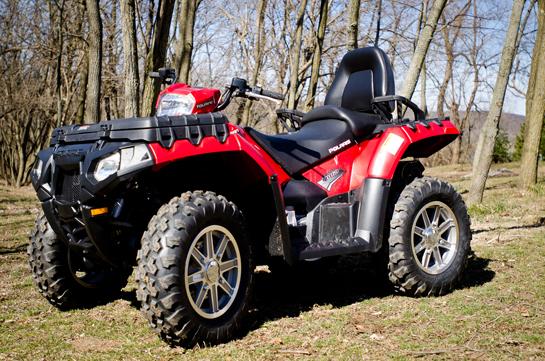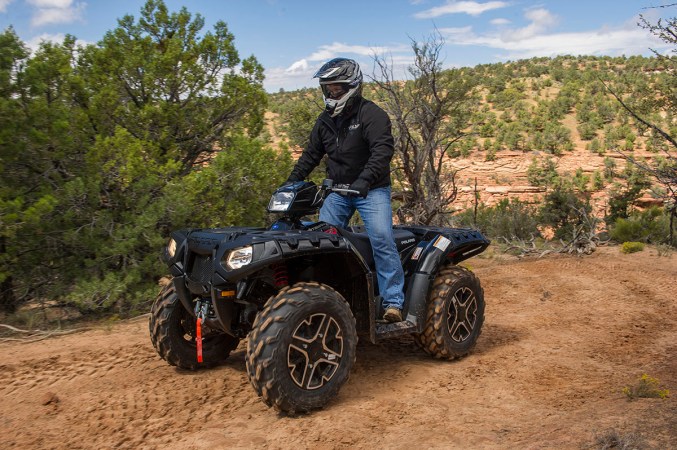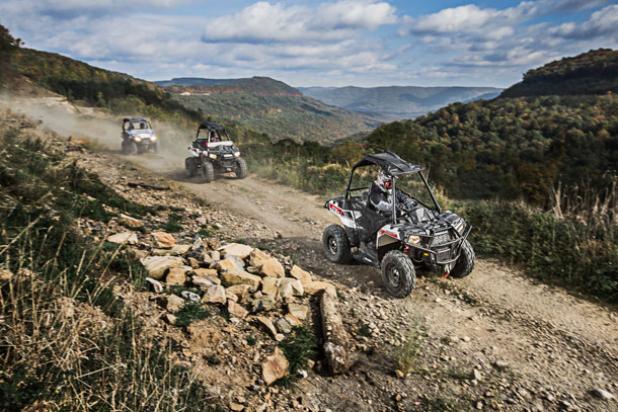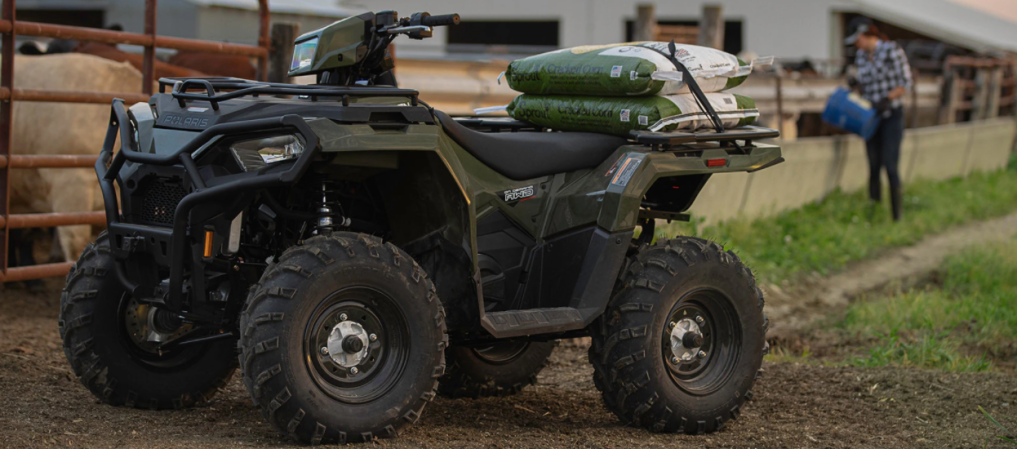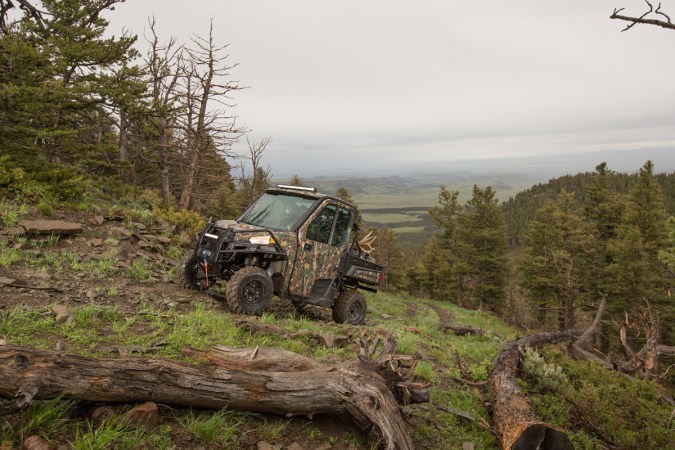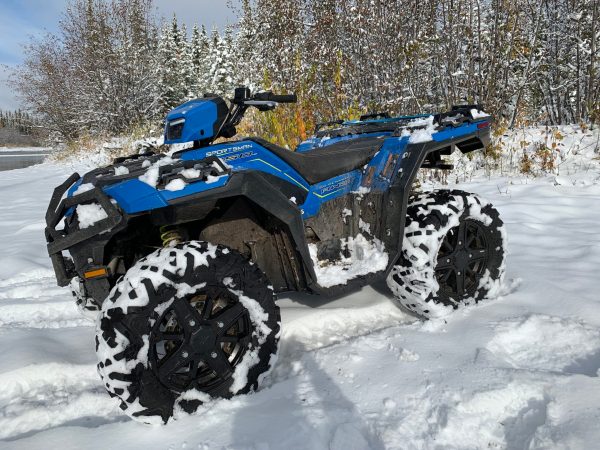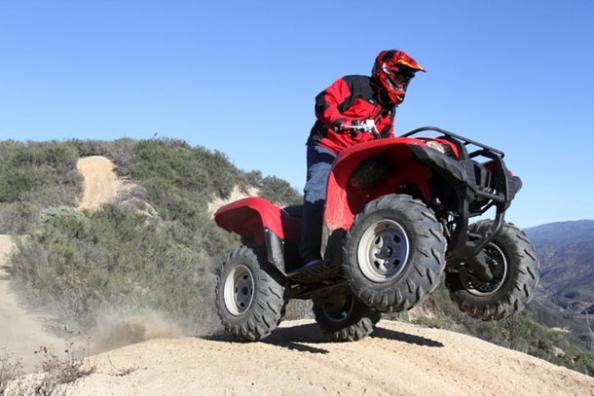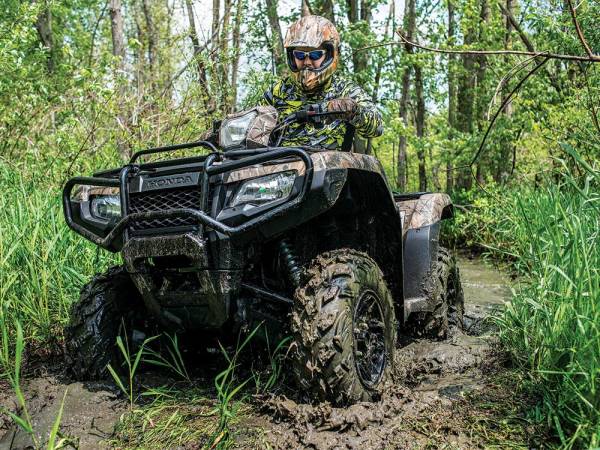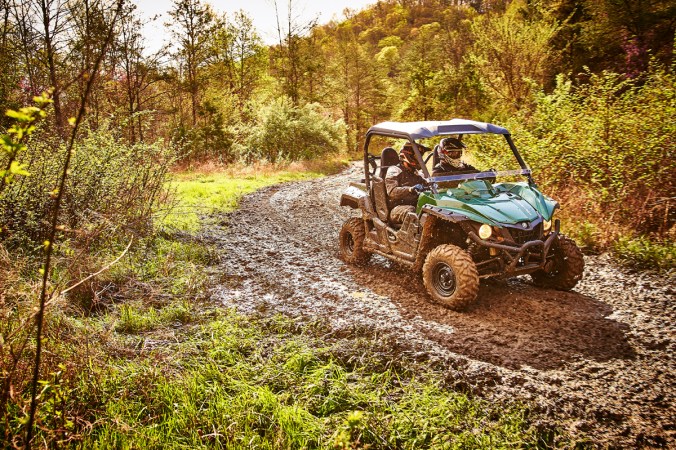We may earn revenue from the products available on this page and participate in affiliate programs. Learn More ›
2012 Polaris Sportsman Touring 550
MSRP: $8,699
Final Thoughts + Polaris Sportsman 550 At a Glance
I recently logged approximately 150 miles aboard the Polaris Sportsman 550. I tested the unit by towing a landscape trailer around my property, meandering down tight, high-speed trails, giving it the occasional mud bath, and using the machine in the same way most owners would. The Sportsman 550, in my opinion, is a comfortable ride that delivers like the larger Sportsman 850. And it won’t hurt your wallet as much.
To the untrained eye, the Sportsman 850 and 550 look nearly identical. It’s only when the engines fire that the subtle differences emerge. The 550 has less horsepower than the 850, and is about 40 pounds lighter. However, the 550 feels heavier because it doesn’t have enough power to float the front end to avoid obstacles. Drivers can make the 850’s front end feel light by stabbing the throttle.
Performance wise, 550’s Engine Braking System (EBS) performed flawlessly when I took it down steep, winding trails. The EBS felt natural, like the engine was actually doing the compression braking itself rather than relying on electronics and clutching.
The On-Demand True All Wheel Drive (AWD) system monitors the difference between the speed of the front and rear wheels, and transfers power to the front wheels only when rear slippage is detected; unlike the typical four-wheel drive system used by the rest of the industry–where the front and rear drivetrain are locked together permanently via a locked clutch when 4×4 is engaged.
Paired with the Electronic Power Steering, the engagement of the AWD was almost imperceptible in my tests, even with all four wheels clawing for traction. The EPS system functions even when the ATV is sitting still or when the engine isn’t running, which I prefer.
The separate headlight pod mounted to the handlebar is a nice touch. I was able to light the trail in the direction I pointed the bars rather than just where the front of the Sportsman was pointed. This could be handy when operating at night, and can help avoid a collision on the trail before it happens. Simply turn the ignition key to the “on” setting. I was also able to turn the handlebars with my pinky finger. Try that on the non-EPS model and your pinky will hate you.
The Sportsman 550 also looks as good as it performs. The chassis makes the 550 the most comfortable ATV, period. It furnished a smooth ride at low speeds, and retained the ability to absorb harder hits that arrived via high-speed impacts with rocks or ruts strewn about the trail.
The bars and controls in the saddle are easily reachable and intuitively placed. The single lever brake system stops the Sportsman 550 efficiently, but I prefer separate front and rear brakes for my riding style. The floorboard-mounted rear brake pedal is located a bit too high, making it difficult to reach with a stiff riding boot. Plus, the brake pedal feels numb and doesn’t have the confident feel to stop the Sportsman that the handlebar lever provides.
The floorboards and bodywork do a nice job of keeping the rider clean and dry. However, when mud does make it onto the floorboards, it will adhere rather than pass through due to the lack of larger holes on the floorboards. The plastic bodywork looks sharp and is one of the most impact-resistant designs in the industry–it keeps the plastic looking good much longer than unpainted plastic.
The Polaris Lock & Ride rack system provides a safe and secure method of mounting accessories to, or in place of, the standard rack. Many accessories available through Polaris attach within seconds to the racks. Care must be taken when ratchet-strapping cargo to the plastic racks because they can crack when tightened too much.
I took the Sportsman 550 on quite a few trail excursions. The terrain where I rode was full of sharp rocks that chew up tires. Fortunately, I never suffered a flat on this model. However, due to the large rear storage bin–bigger than many of the larger machines currently available–I was able to bring a portable compressor, tire plugs, and some fresh H2O along.
Final Thoughts
At $8,699, the Polaris Sportsman 550 gives buyers big-bore capability and capacity at a midsize price point. With identical chassis dimensions and towing and rack capacity, the Sportsman 550 will get the job done just as easily as the Sportsman 850. One downside is that the 550 is not nearly as fun to ride as the torquey 850. If an extra $1,300 in your pocket is worth more than the extra power most users really don’t need, the Sportsman 550 will make a great new ride.
Polaris Sportsman 550 At a Glance
HITS
– On-Demand True All-Wheel Drive keeps steering effort light by only engaging the front drivetrain when absolutely necessary.
– EBS feels natural and nearly imperceptible.
– Long front and rear suspension travel.
– Power steering works even when the Sportsman 550 isn’t in motion.
– EPS is a phenomenal addition and worth every penny.
– Painted plastic bodywork has automotive quality looks with off-road durability.
– Removable Lock & Ride storage box is sleek and adds more hauling capability.
– A separate bar mounted headlight is an inexpensive way to provide added safety for night riding.
MISSES
– At 733 pounds, the 550 is heavier than most machines with a mid-size engine.
– ADC can be intrusive in technical crawling situations and requires being switched on/off.
– $600 premium for a Special Edition model that adds different colored paint and decals seems a bit steep.
– Would love to see an optional front brake lever.
– Large floorboards can pack with mud when it’s very messy.
– Cranking cargo down too tightly may crack the plastic Lock & Ride racks.
– Rear storage bin is not completely waterproof.

